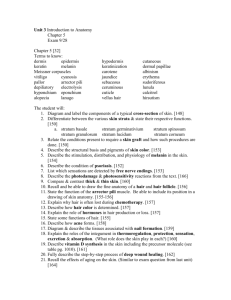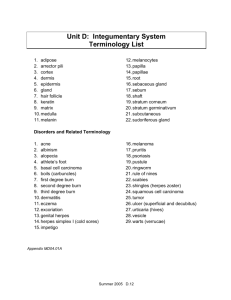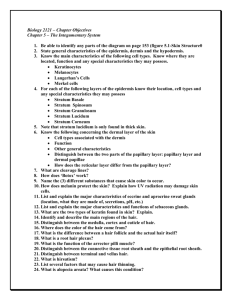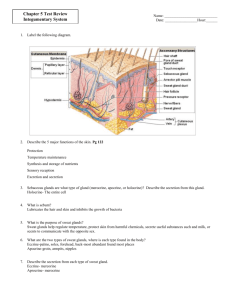Skin & Body Membranes Workbook: Anatomy & Physiology
advertisement
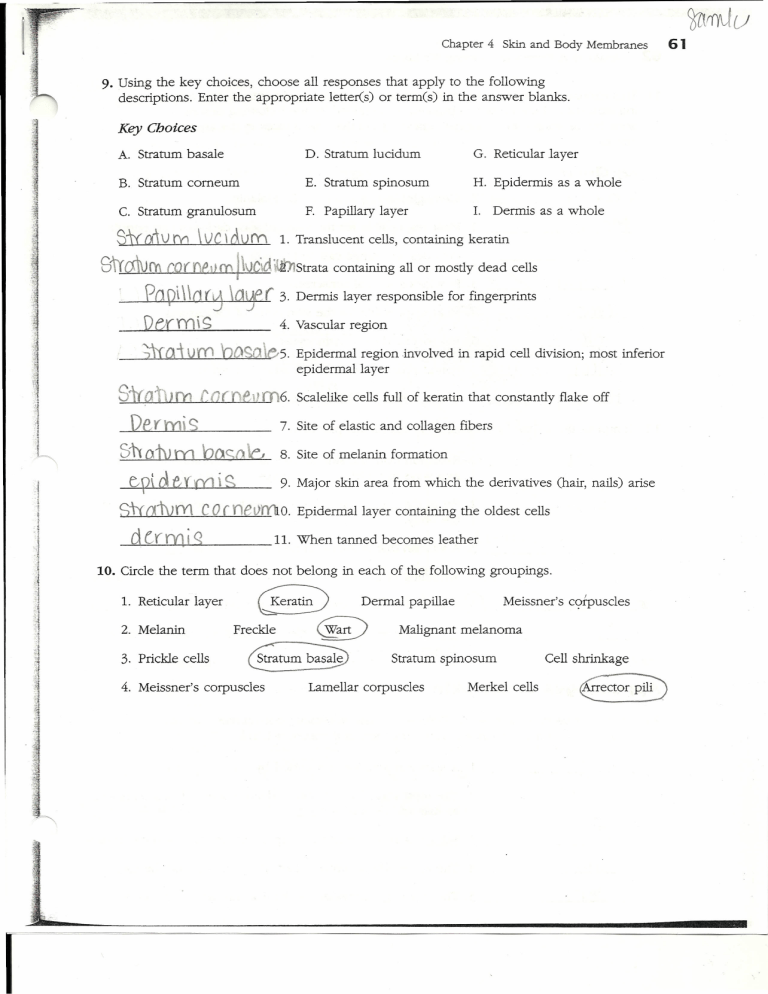
%ltrJY0tu
Chapter 4 Skin and Body Membranes
9. Using the key choices, choose all responses that apply to the following
descriptions. Enter the appropriate
letter(s) or term(s) in the answer blanks.
Key Choices
A. Stratum basale
D. Stratum lucidum
G. Reticular Iayer
B. Stratum corneum
E. Stratum spinosum
H. Epidermis as a whole
C. Stratum granulosum
F. Papillary layer
1. Dermis as a whole
SlY eX1 V rY\
\
V c ,d u rY'I
ste atvrn COf tlPI' m l~'
PoD\\ \0 (~ \a~(
Qerm\s
1. Translucent cells, containing keratin
.
Strata containing all or mostly dead cells
3. Dermis layer responsible for fingerprints
4. Vascular region
;tcDl Urn bDSO\e.-S.
Epidermal region involved in rapid cell division; most inferior
epidermal layer
Stra m
6. Scalelike cells full of keratin that constantly flake off
_De y mi S
7. Site of elastic and collagen fibers
S'h oW tY1 b{)~O\6
t,oi d t r (Y1 i S
8. Site of melanin formation
9. Major skin area from which the derivatives (hair, nails) arise
I
SiY ((Nm
cor neum.o.
Epidermal layer containing the oldest cells
dtrmig
10. Circle the term that does not belong in each of the following groupings.
1. Reticular layer
2. Melanin
3. Prickle cells
~ra~
Dermal papillae
Freckle
~tum
4. Meissner's corpuscles
Grt~
~
Meissner's corpuscles
Malignant melanoma
Stratum spinosum
Lamellar corpuscles
Merkel cells
Cell shrinkage
Ectorp?i)
61
r•••••••••••••••••••••••••••••••••••••••••
~\
62
Anatomy & Physiology Coloring Workbook
.11. This exercise examines the relative importance of three pigments in determining skin color. Indicate which pigment is identified by the following descriptions by inserting the appropriate answer from the key choices in the answer
blanks.
Key Choices
C. Melanin
B. Hemoglobin
A. Carotene
\VI ulan i vi
1. Most responsible for the skin color of dark-skinned people
---"ca::...;....:.r'-o:;........!t-"e::::.n~6'----
2. Provides an orange cast to the skin
--.l..M.......l.-"B"-,I,-,,Ql!Y1.....!...!.i
.!...n.L:.'----___ 3. Provides a natural sunscreen
_HfJYY1og'abi n
n~.
---'r"_/.:.....:16=--l....::.Q.:...!n_l.:......:·
5. Phagocytized by keratinocytes
_-""G'-'O<..l..(!.....o"-±-+-'e'""-o~(J~
_\.1-1,-,'
eoLeJm'--!....!.-vOC!..<f!T'\u,Ol-'D!2..L.\
4. Most responsible for the skin color of Caucasians
6. Found predominantly in the stratum corneum
\'").!.....!...._
7. Found within red blood cells in the blood vessels
J
12. Complete the following statements in the blanks provided.
Q;vbcvtone,ouS
_-'O""-'-'"d"'-l,'+p•.•O"-S..........",b"'--___
~
1. Radiation from the skin surface and evaporation of sweat are
two ways in .which the skin helps to get rid of body --.DL.
2. Fat in the ~
the body.
tissue layer beneath the dermis helps to insulate
__ ---"D"--______
3.
_.:::::e:....:\-"'o-"Gi!-h......,·L.!>.L..\"-"--''+-__
4. Wrinkling of the skin is caused by loss of the ~
0 Y..\J.,\fAJ e (l
_.!o.C.wA'4'IQ""-.L.n..L:t1~c;L.!.i-,,=s,--- __
J
A
vitamin that is manufactured in the skin is
0 A decubitus
\.21
(3).
of the skin.
ulcer results when skin cells a~e deprived of
-,J2L.
6. ~
is a bluish cast of the skin resulting from inadequate
oxygenation of the blood.
Appendages of the Skin
13. For each true statement, write T For each false statement, correct the
underlined word(s) and insert your correction in the answer blank.
,
1. A saltwater solution is secreted by sebaceous glands.
.!
----...:w=--------
2. The most abundant protein in dead epidermal structures such
as hair and nails is melanin.
3. Sebum is an oily mixture of lipids, cholesterol, and cell fragments.
_t-~____4. The externally observable
_-->.<S<....:D-'--"'o'-..•..
-t
_---"~~/:.L('_m.!!._L..!...l'-"~"--
part of a hair is called the root.
5. The epidermis provides mechanical strength to the skin.
.'~
:
f
Chapter 4 Skin and Body Membranes
63
14. Figure 4-3 is a diagram of a cross-sectional view of a hair in its follicle.
Complete this figure by following the directions in steps 1-3.
1. Identify the two portions of the follicle wall by placing the correct name
of the sheath at the end of the appropriate leader line.
2. Use different colors to color these regions.
3. Label, color-code, and color the three following regions of the hair.
o
~
Cortex
o
Cuticle
Medulla
Follicle
wall
C onnecti
Epd'he,hl\ l
\If;
Gheo.+h
TisSue, Ghecrth
Figure 4-3
15. Circle the term that does not belong in each of the following groupings.
1. Luxuriant hair growth
2. Vitamin D
36'atum
5. Terminal hair
~ ~at
Cholesterol
corne~
4. Scent glands
Testosterone
IN radiation
Nail matrix
~rine
@i"s
~
glan~
hair)
is the scientific term for baldness?
nutri~
6;era~
Hair bulb
Stratum basale
Apocrine glands
Dark, coarse hair
A'
Q pLf/ac..£-!.!l
Good blood supply
Axilla
Eyebrow hair
Q-4--------
64
Anatomy & Physiology Coloring Workbook
17. Using the key choices, complete the following statements. Insert the
. appropriate letter(s) or term(s) in the answer blanks.
Key Choices
A. Arrector pili
C. Hair
E. Sebaceous glands
B. Cutaneous receptors
D. Hair follicle(s)
F. Sweat gland (apocrine)
Se\Jaccovs a\onllis
1. A blackhead is an accumulation of oily material produced by
J
a..:..:.r....:..(~e=ctv:....!.-=.---.:-r-----1?f!--'-\
~.
2. Tiny muscles attached to hair follicles that pull the hair upright
during fright or cold are called ~.
..!....\\.!....- __
sweat kcaine
'a\t\och.
) J
-!.h...l.!.OL...!-\
r=--....!£o\-lL-\.!....C\~i-"!:c::...:.\~v~_
b\NCOt
The most numerous variety of perspiration gland is the ~.
4. A sheath formed of both epithelial and connective tissues is
the~.
la~¥ I()t)
5. A less numerous variety of perspiration gland is the
(5). Its
secretion (often milky in appearance) contains proteins and
other substances that favor bacterial growth.
__ \1 ,-"O,-,--,--\-'-.(
6. ~
is found everywhere on the body except the palms of the
hands, soles of the feet, and lips, and it primarily consists of
dead keratinized cells.
L
CV10()COUS YeLfak.r:g7. ~
'
SebDCeOvS Cj.
and
lo.pOc,rioe)
SWtat
svv e 0. t
Se- bo
t
G. Sweat gland (eccrine)
eCG
8. ~
r\ oe,)
r.e 0 vS
are specialized nerve endings that respond to temperature
touch, for example.
become more active at puberty.
9. Part of the heat-liberating apparatus of the body is the ~.
10. Secretin contains bacteria-killing
substances.
18. Circle the term that does not belong in each of the following groupings,
1, Sebaceous gland
2. Radiation
3. Cortex
4. Scent glands
5. Cyanosis
Hair
~ector
Cuticle
GCCrine glan~
Erythema
Epidermis
Conduction
(Absorption)
Medulla
p!9
~e5)
~thelial
Evaporation
Sh~
Apocrine glands
Pallor
Axilla
.~
